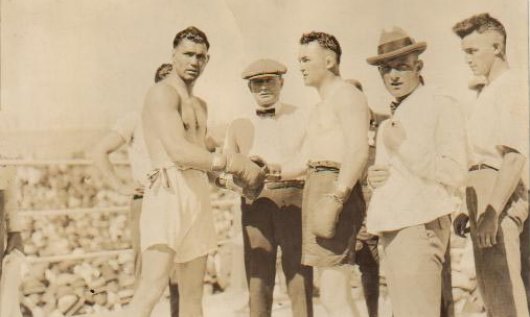
Molumby’s Million by DW Gregory; John Doyle directed. Iron Age Theatre through November 28, 2010 at Centre Theater, Norristown, PA.
I grew up watching the Friday night fights on TV, and also saw film clips of a lean and mean Jack Dempsey slugging his way to fame in 1919. The first time my parents took me to New York City, I insisted on walking into Dempsey’s Times Square restaurant to see the ex-champ in person. (Every evening he sat at a table near the front door.)
So if you’re presenting a play about boxing, count me in. But it takes a much wider range of content to attract audiences in this day and age.
Happily, Molumby’s Million provides that range. DW Gregory’s drama, in its world premiere, tells of the managers, promoters and fortune hunters who swarmed around Dempsey. The play centers on a real-life oil magnate named Molumby who promised a million-dollar gate to induce Dempsey to defend his title on the Fourth of July in the tiny town of Shelby, Montana in 1923.
When Dempsey’s manager, Jack “Doc” Kearns, denigrates Shelby’s potential, Molumby speaks optimistically of hope, trying to tap into the idealism that accompanied America’s victory in World War I. Hope, says Molumby, made Shelby an emblem of America’s emerging Western states.
To be sure, one synonym for hope is speculation, and that is a more accurate description of what was going on. Molumby speculated when he drilled for oil, and he speculated in a big way when he guaranteed Dempsey as well as Shelby’s civic leaders a huge profit from the heavyweight championship fight.
When Dempsey said he wouldn’t fight if he weren’t paid, Molumby ironically decried that attitude as poor sportsmanship. He expected athletes to entertain the public even though he, as a businessman, wouldn’t do anything except for money. Oil speculation, stock speculation, real estate speculation were OK — but athletes should abide by a different set of rules.
A week before the fight the Great Western Railroad pulled out of the deal. People would now have to get to Shelby by horse and wagon, automobile or on foot. The enterprise became a fiasco. In the end the town couldn’t come up with the final payment, but Dempsey wanted to fight Gibbons cash or no cash. He was rusty and bored after two years out of the ring. The fight went on; Dempsey won by decision.
The playwright, DW Gregory, has written other plays that draw on her own working-class roots near Lancaster, Pennsylvania. Much of the information in Molumby’s Million comes from the writings of Damon Runyon, who covered Dempsey as a young journalist. Luke Moyer’s excellent portrayal of Runyon eschews the Guys-and-Dolls Broadwayese that later became Runyon’s trademark. (Runyon actually grew up in Colorado, as did Dempsey.)
Dempsey is portrayed sympathetically by Howie Brown. Similarly, Gregory’s Molumby is no stock villain. Anthony M. Giampetro plays him with complexity, giving the production nuance. Ray Saraceni is colorful as Doc Kearns.
John Doyle directs briskly. Dave Mason designed the fight choreography and also played the role of Dempsey’s opponent, Tommy Gibbons.
The big losers are the investors from Shelby. Only 7,700 fans paid to see the fight. The town’s three banks went bankrupt. Today Shelby is not much larger than it was before the big fight.
Read more about it here:
This article originally appeared in Broad Street Review